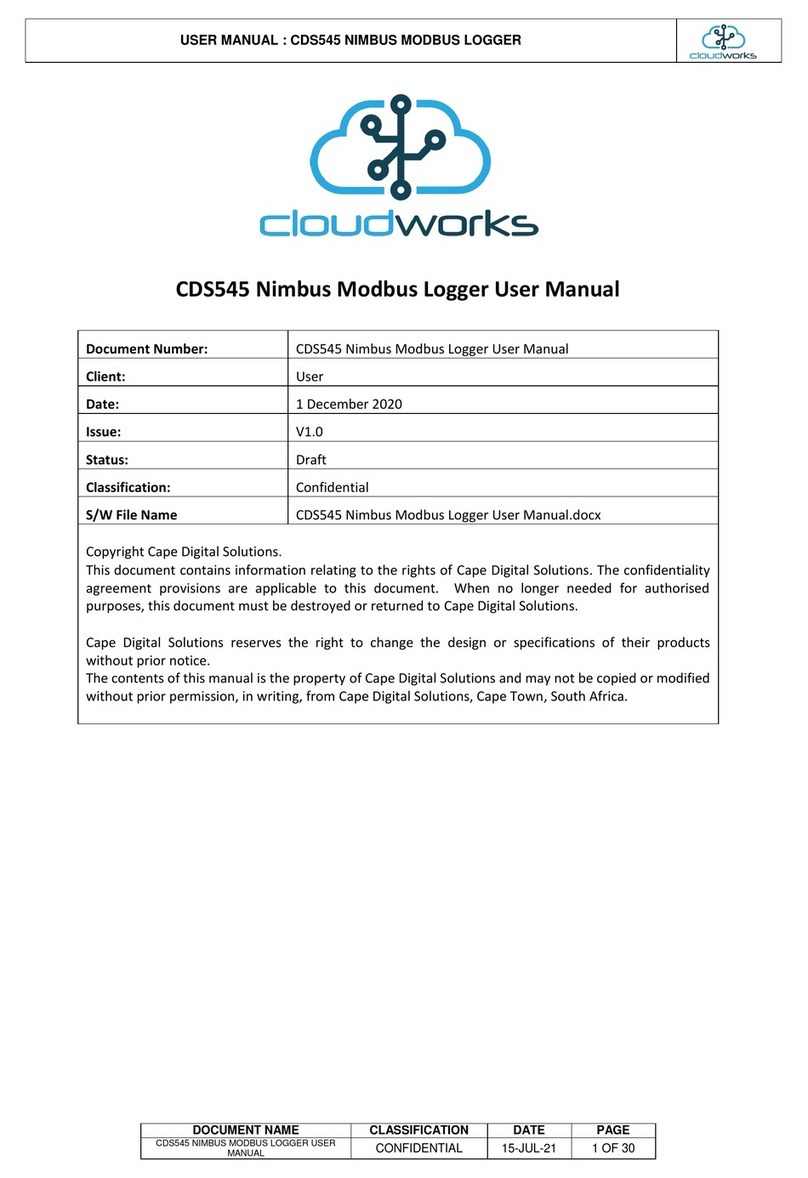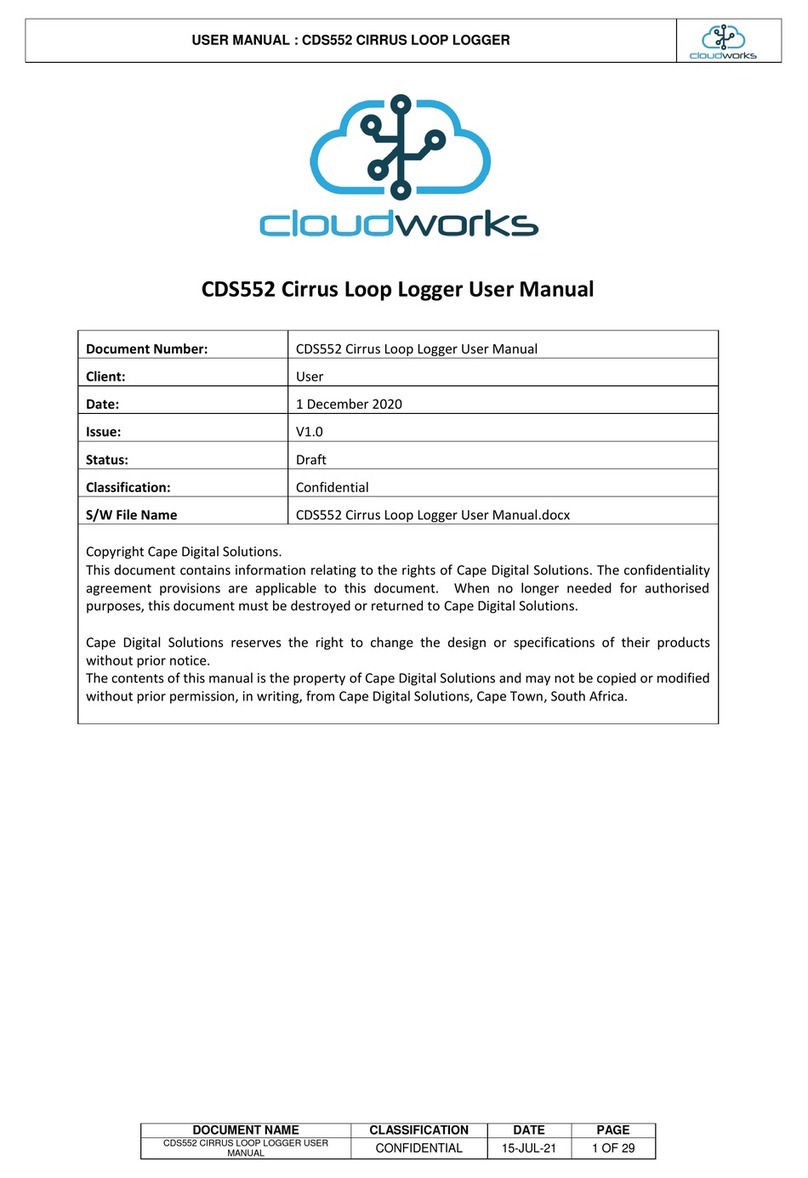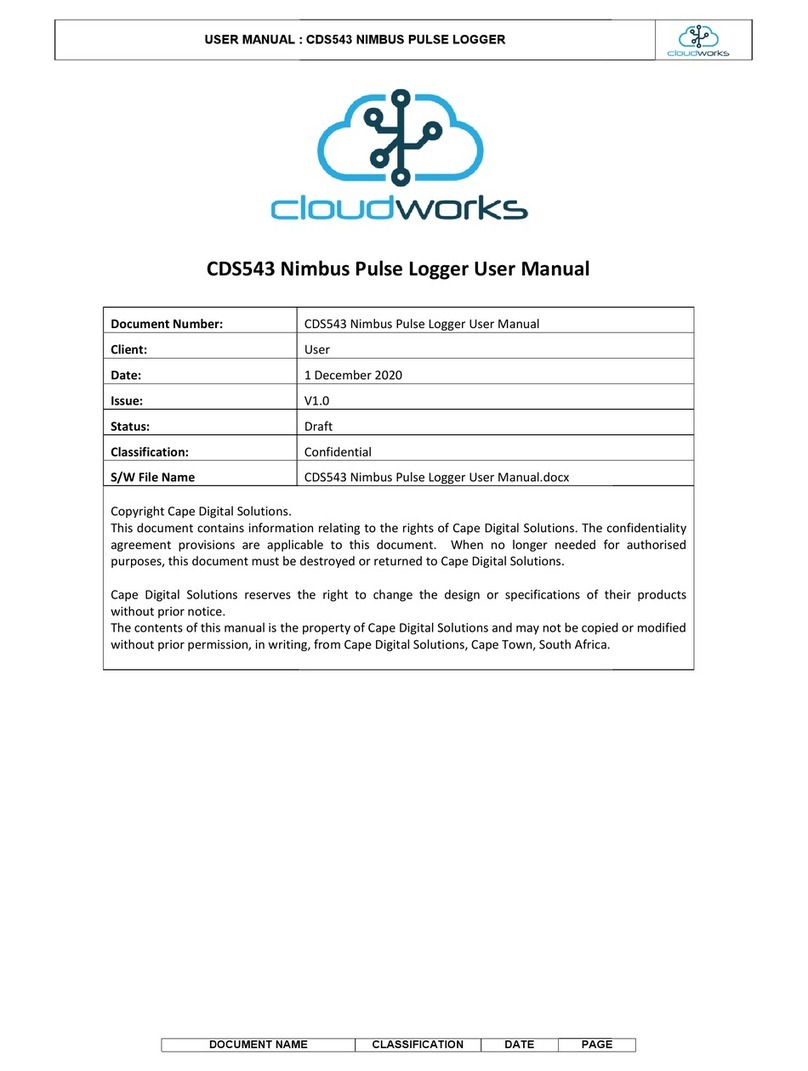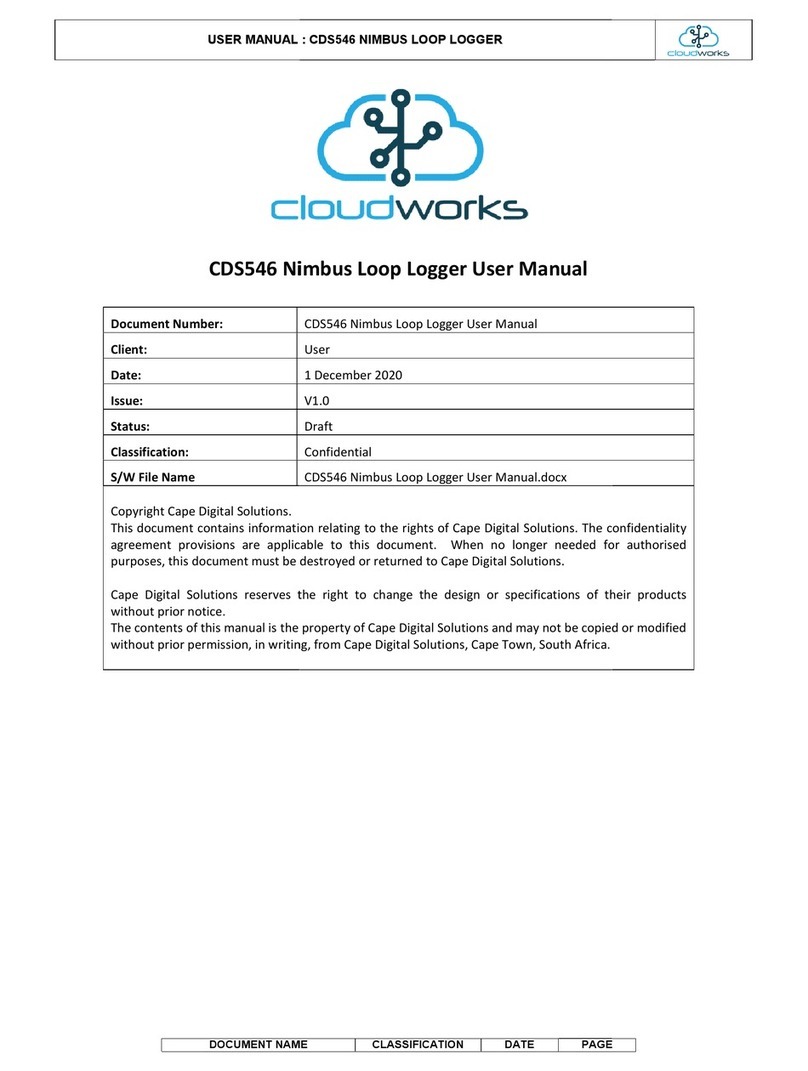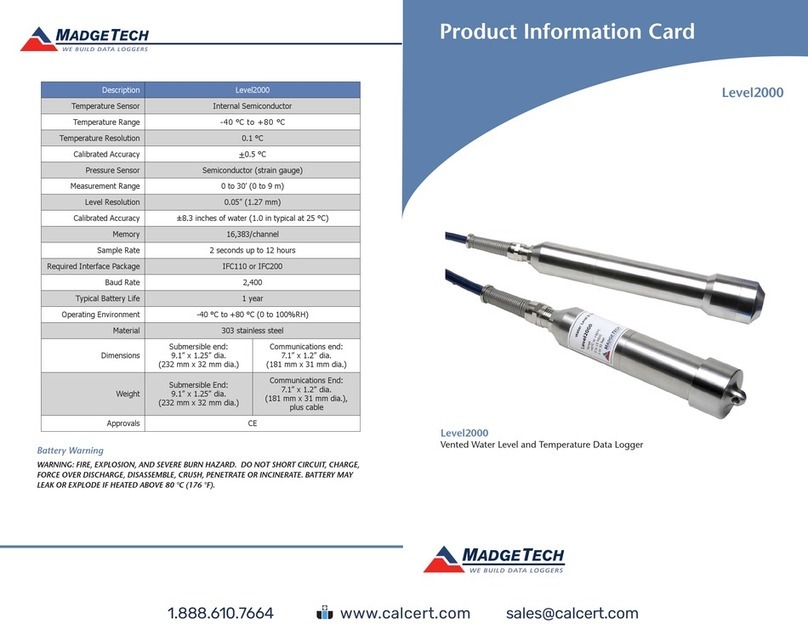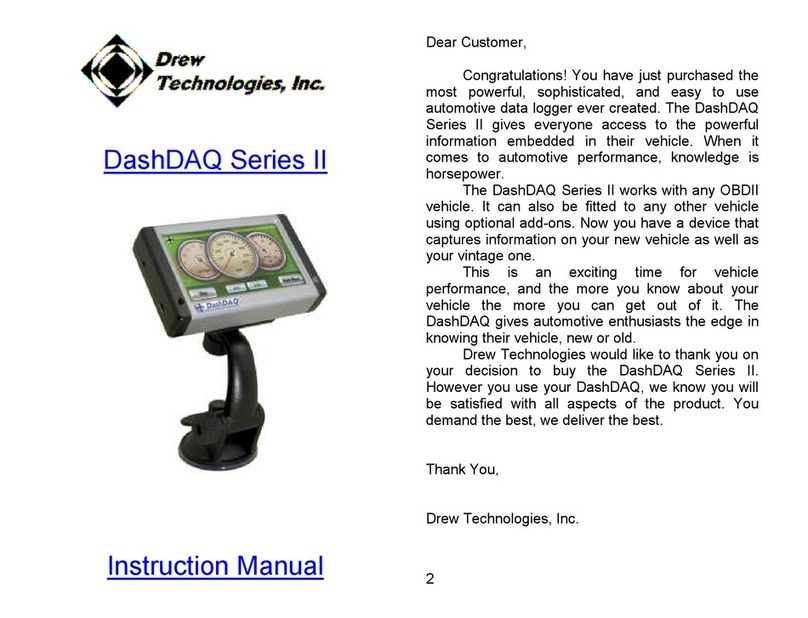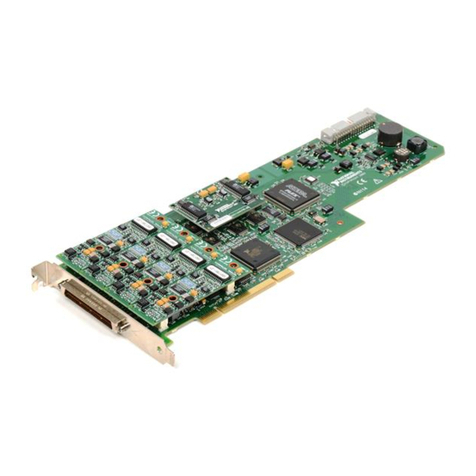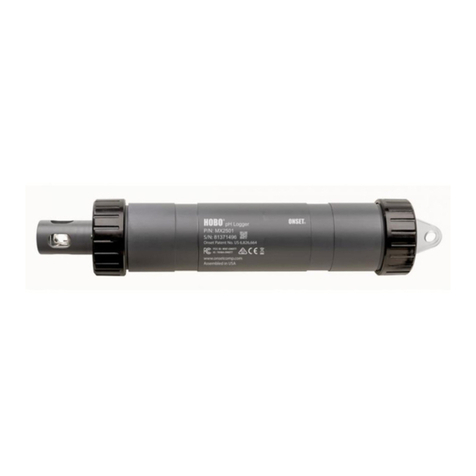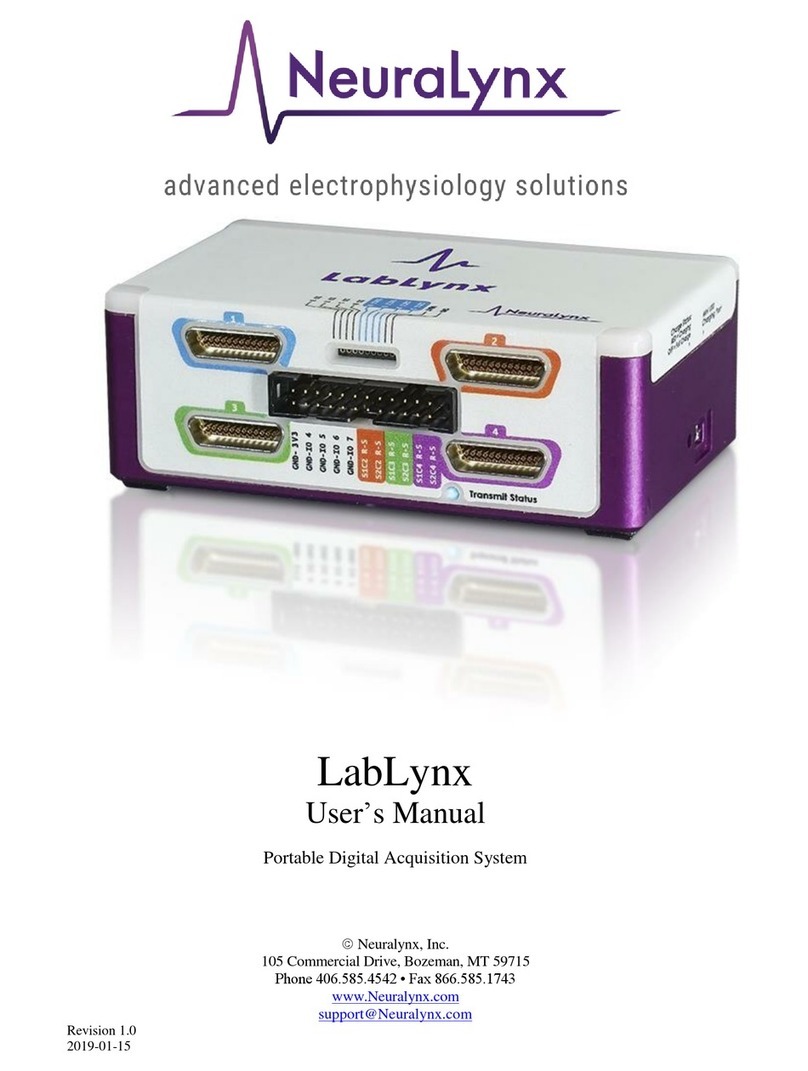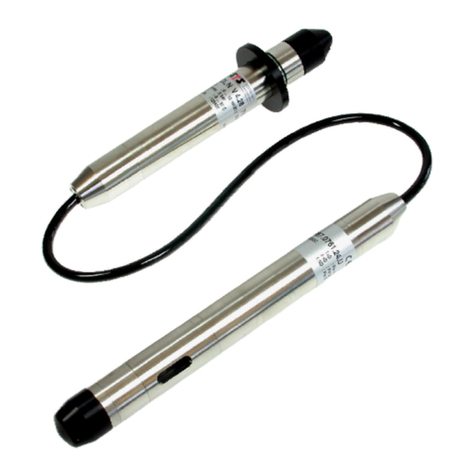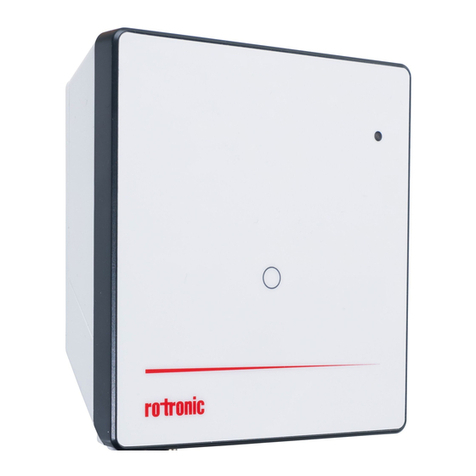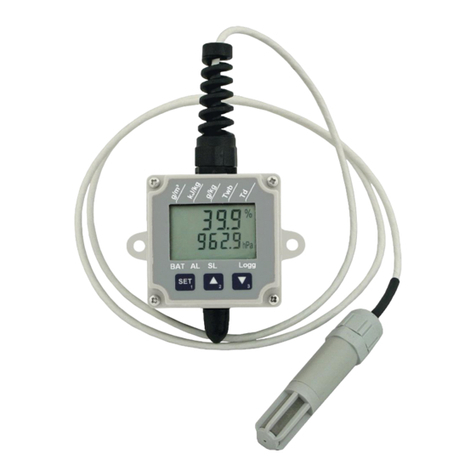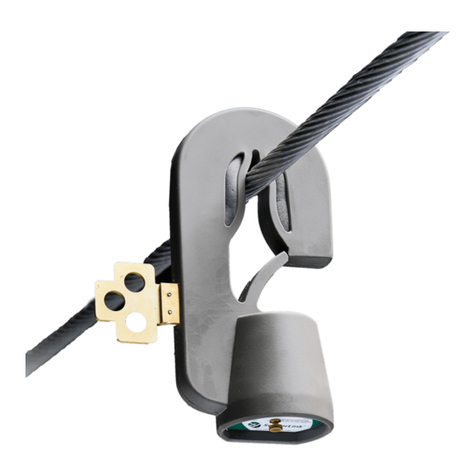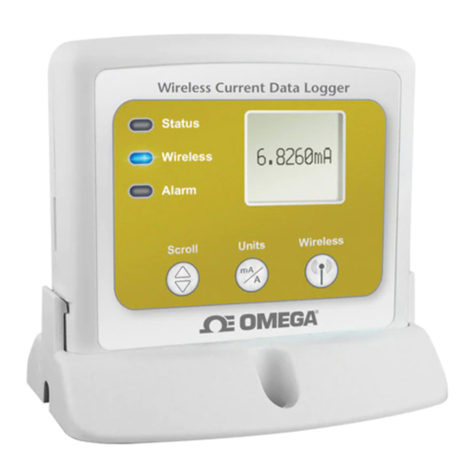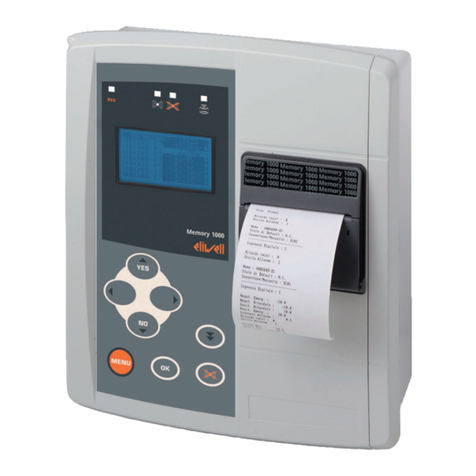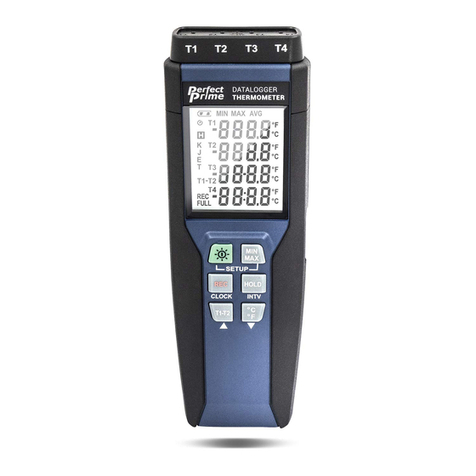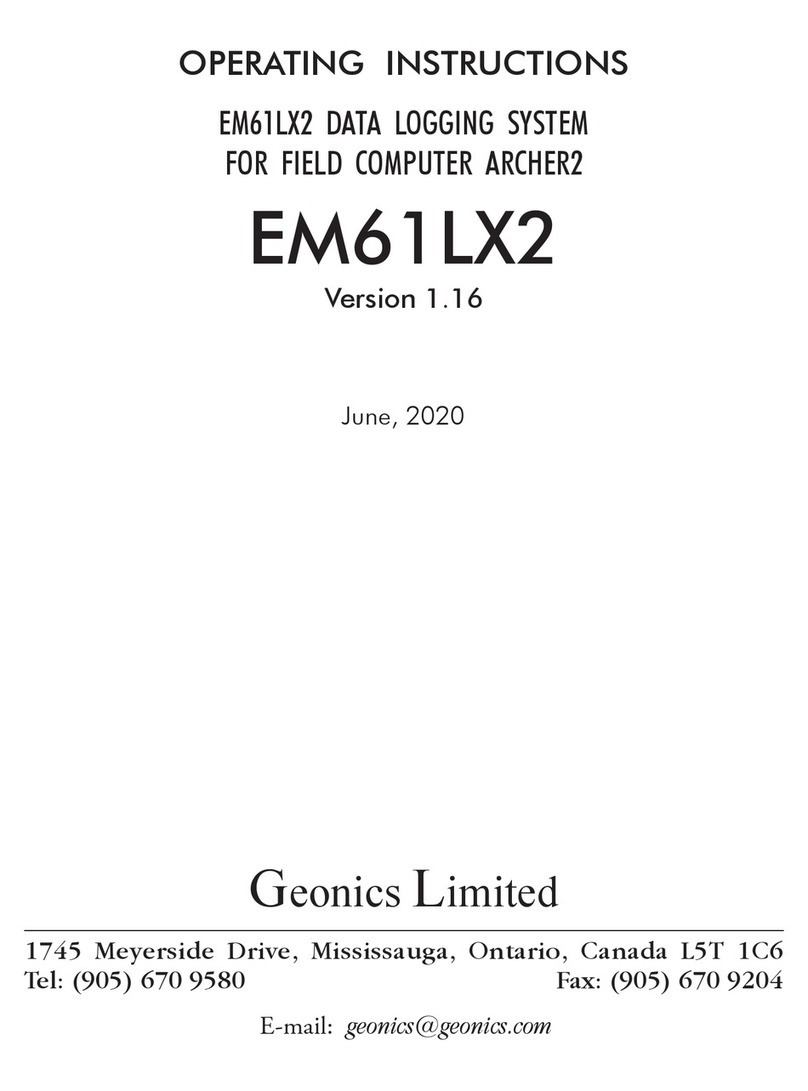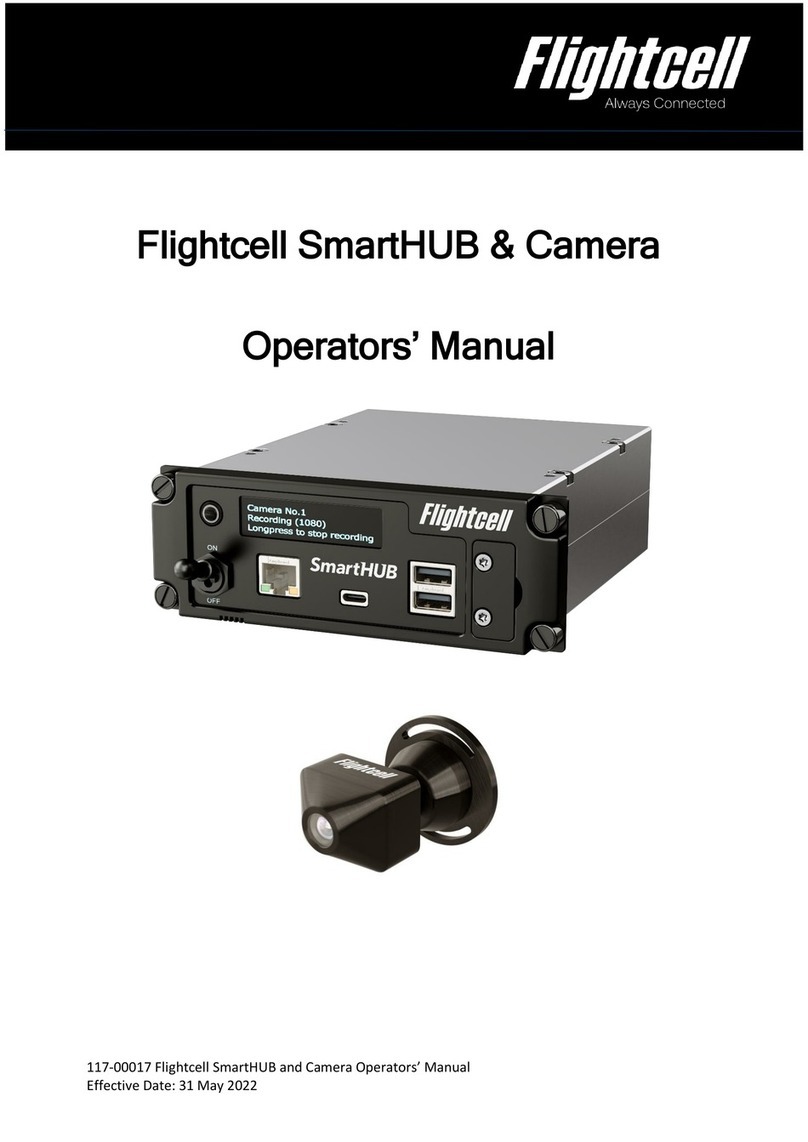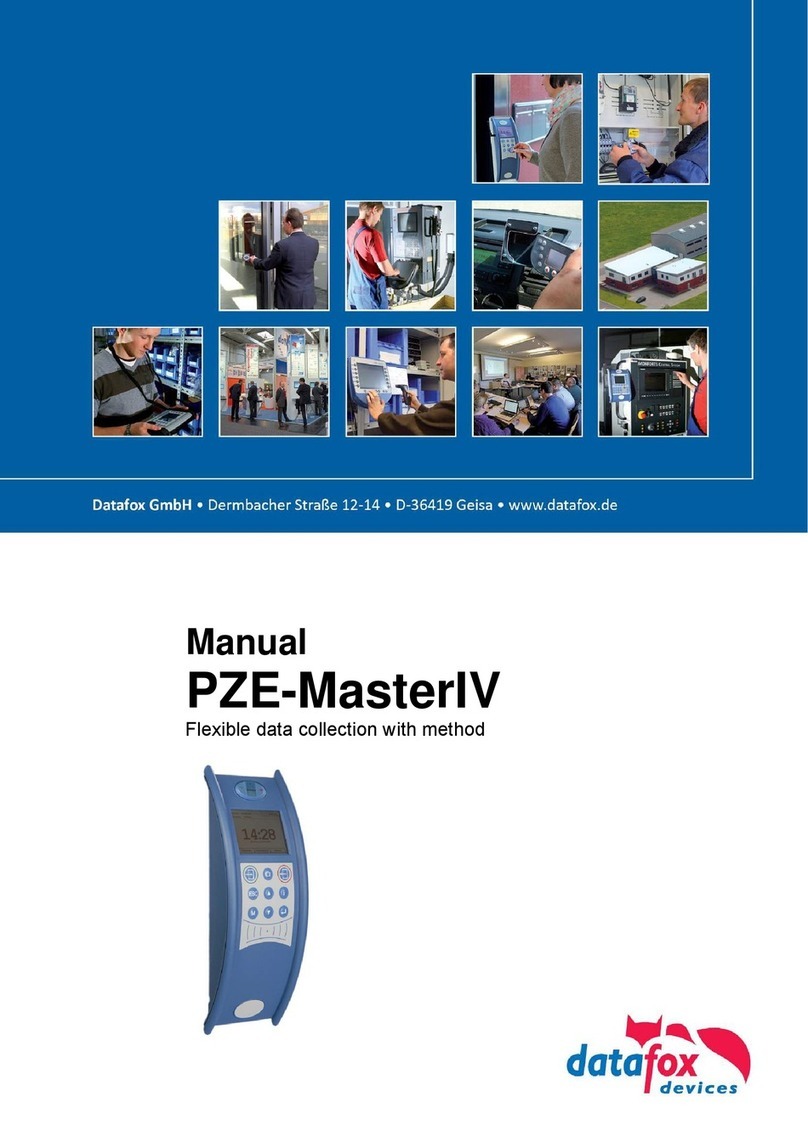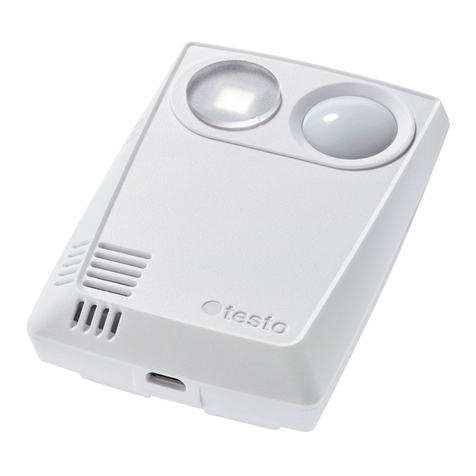cloudworks CDS541 User manual

USER
MANUAL :
DOCUMENT
NAME
CDS541
Cumulus Pulse
Document Number:
Client:
Date:
Issue:
Status:
Classification:
S/W File Name
Copyright Cape Digital Solutions.
This document contains information relating to the rights of
agreement provisions are applicable to this document. When no longer needed for authorised
purposes, this document must be destroyed or returned to
Cape Digital Solutions
reserves the right to change the desi
without prior notice.
The contents of this manual is the property
without prior permission, in writing, from
MANUAL :
CDS541 CUMULUS PULSE LOGGER
NAME
CLASSIFICATION
DATE
PAGE
Cumulus Pulse
Logger User Manual
CDS541 Cumulus Pulse Logger User Manual
User
28 February 2018
V2.0
Draft
Confidential
CDS541 Cumulus Pulse Logger User Manual.docx
This document contains information relating to the rights of
Cape Digital Solutions
. The confidentiality
agreement provisions are applicable to this document. When no longer needed for authorised
purposes, this document must be destroyed or returned to
Cape Digital Solutions.
reserves the right to change the desi
gn or specifications of their products
The contents of this manual is the property
of Cape Digital Solutions
and may not be copied or modified
without prior permission, in writing, from
Cape Digital Solutions, Cape Town, South Africa.
PAGE
. The confidentiality
agreement provisions are applicable to this document. When no longer needed for authorised
gn or specifications of their products
and may not be copied or modified

USER
MANUAL :
DOCUMENT
NAME
Issue Date
V01 28 Feb 2018
V02 25 Jul 2019
V03 19 Jan 2021
MANUAL :
CDS541 CUMULUS PULSE LOGGER
NAME
CLASSIFICATION
DATE
PAGE
AMENDMENT HISTORY
Amendment Details
Amended By
Compile document
Alex Romanov
Updated modem technology specs
Alex Romanov
New configuration text
Alex Romanov
PAGE
Amended By
Alex Romanov
Alex Romanov
Alex Romanov

USER
MANUAL :
DOCUMENT
NAME
Table of Contents
1
CDS541 Cumulus Pulse Logger
1.1
Introduction ................................
................................
1.2
Features ................................
................................
1.3
Specifications
................................
1.4
Architecture ................................
................................
1.5
Power Modes
................................
1.6
LED Functions
................................
1.7
Pushbutton Functions
................................
1.8
Connections
................................
1.8.1
External Power Supply / Solar System Connection
1.8.2
Using the Digital Output
................................
1.8.3
Using the Digital Input
................................
1.8.4
Using the 4-
20mA loop input and 24V loop power generator
1.8.5
Using the Pulse Input with echo output
1.8.6
Using the ECO interface
................................
2
Logger Setup
................................
2.1
Setup via Bluetooth Configure
................................
2.2
Setup via Remote Configure
................................
2.3
Setup via Offline Script Configure
MANUAL :
CDS541 CUMULUS PULSE LOGGER
NAME
CLASSIFICATION
DATE
PAGE
CDS541 Cumulus Pulse Logger
................................
................................
................................
................................
...........................
................................
................................
...............................
................................
................................................................
.......................
................................
................................
..........................
................................
................................................................
.......................
................................
................................................................
......................
................................
................................................................
...........
................................
................................................................
.........................
External Power Supply / Solar System Connection
................................
.....................
................................
................................
...............................
................................
................................
................................
20mA loop input and 24V loop power generator
................................
Using the Pulse Input with echo output
................................................................
......
................................
................................
.............................
................................
................................
..............................
................................
................................
...........................
................................
................................
..............................
Setup via Offline Script Configure
................................................................
......................
PAGE
................................
.. 4
...........................
4
...............................
4
.......................
5
..........................
6
.......................
7
......................
7
...........
7
.........................
8
.....................
9
...............................
9
................................
10
................................
.... 10
......
11
.............................
12
..............................
13
...........................
16
..............................
26
......................
28

USER
MANUAL :
DOCUMENT
NAME
1 CDS541 CUMULUS PULSE
LOGGER
1.1 Introduction
The Cumulus Pulse
logger is a robust, sophisticated 3G GSM logger/controller with a wide range of input/output
capabilities, making it ideal for a
large number of uses including utility and r
Standard in this l
ogger is a GPS receiver allowing for the precise location determina
Communication to your own server
and database can be achieved
on these servers is supplied free of charge.
setup without the need for a complicated se
supplied free of charge to allow clients to manage their own networks and data. There are no monthly charges for
collecting and hosting data as the client can provide this service themselves
1.2 Features
Uses 3G GSM (UMTS/HSPA) technology. Thi
world will soon no longer be supporting older GPRS techn
This has already started happening in many countries around the world.
Onboard GPS. Networks are plotted automatically on Google Earth giving the client a precise location of assets in
the field.
Bluetooth interface -
setup and manual data collection can be achieved through the Bluetooth interface negating
the need for cable
s that invariable fail during continuous use.
Battery or m
ains operated with battery failover in dual mode.
Uses standard off-the-shelf a
lkaline batteries. This logger uses 3x standard D Cell alkaline batteries that
excess of 5 years under no
rmal usage. Many other loggers use
obtain. Other problems involving l
ithium batteries are the restrictions when shipping using airfreight. All
batteries need to be shipped as hazardous cargo tha
are no longer allowing these batteries on their aircraft.
ECO Interface for the connecting to GWF electronic meters.
Isolated 4-
20mA interface. Used for any sensing device
MANUAL :
CDS541 CUMULUS PULSE LOGGER
NAME
CLASSIFICATION
DATE
PAGE
LOGGER
logger is a robust, sophisticated 3G GSM logger/controller with a wide range of input/output
large number of uses including utility and r
emote control/measurement applications.
ogger is a GPS receiver allowing for the precise location determina
tion needed in large networks.
and database can be achieved
via
the internet or a private APN.
on these servers is supplied free of charge.
The Cumulus Pulse
Logger has been designed to allow for easy installation and
setup without the need for a complicated se
rver infrastructure. Setup and m
anagement software (CloudWorks) is
supplied free of charge to allow clients to manage their own networks and data. There are no monthly charges for
collecting and hosting data as the client can provide this service themselves
.
Uses 3G GSM (UMTS/HSPA) technology. Thi
s has become essential as many c
ellular network providers around the
world will soon no longer be supporting older GPRS techn
ologies, rendering legacy GPRS d
This has already started happening in many countries around the world.
Onboard GPS. Networks are plotted automatically on Google Earth giving the client a precise location of assets in
setup and manual data collection can be achieved through the Bluetooth interface negating
s that invariable fail during continuous use.
ains operated with battery failover in dual mode.
lkaline batteries. This logger uses 3x standard D Cell alkaline batteries that
rmal usage. Many other loggers use
l
ithium batteries that are expensive and difficult to
ithium batteries are the restrictions when shipping using airfreight. All
batteries need to be shipped as hazardous cargo tha
t is becoming increasingly difficult to achieve as many airlines
are no longer allowing these batteries on their aircraft.
ECO Interface for the connecting to GWF electronic meters.
20mA interface. Used for any sensing device
with a 4-20mA output.
PAGE
logger is a robust, sophisticated 3G GSM logger/controller with a wide range of input/output
emote control/measurement applications.
tion needed in large networks.
the internet or a private APN.
The software running
Logger has been designed to allow for easy installation and
anagement software (CloudWorks) is
also
supplied free of charge to allow clients to manage their own networks and data. There are no monthly charges for
ellular network providers around the
ologies, rendering legacy GPRS d
ataloggers obsolete.
Onboard GPS. Networks are plotted automatically on Google Earth giving the client a precise location of assets in
setup and manual data collection can be achieved through the Bluetooth interface negating
lkaline batteries. This logger uses 3x standard D Cell alkaline batteries that
can last in
ithium batteries that are expensive and difficult to
ithium batteries are the restrictions when shipping using airfreight. All
lithium
t is becoming increasingly difficult to achieve as many airlines

USER
MANUAL :
DOCUMENT
NAME
Onboard 24V 30mA power generator. The
of 30mA allowing for the powering of an external piece of equipment or current loop device eliminating the need
for a secondary power supply. This
2 x Pulse inputs with echo output
measured amount of product. The echo output will allow this logger to be connected in conjun
device requiring use of the same pulse output.
1 x Digital input - U
sed for general input application.
1 x Digital output (max 500mA at
50
Large onboard non-
volatile memory
Application dependent.
Logging intervals from 1 minute to 1 month. Information is internally logged, time and date stamped and
transmitted at programmable intervals
Remote programming of all setup parameters via GPRS link or SMS.
Ideal for leak detection, alarming and water shut
Onboard Bluetooth can stream diagnostic information about signal strength,
Pushb
utton and LED's for manual wakeup to server and diagnostic purposes etc.
1.3 Specifications
GPRS multi-
slot class 12/ EDGE multi
Onboard GPS
Bluetooth interface
Powered by battery, mains or external 12V supply
Option of mains/solar
power with battery failover and sleep
All management software supplied free
Standard Alkaline Batteries -
3 x D cells
ECO Interface for GWF meters
24V 30mA Generated power o
utput
2 x Pulse inputs with echo out
1 x Digital input
1 x 500mA max 50V Output
Isolated 4-20mA Input port
11000 Record datalog memory
(application dependent)
Full SMS driven command set
Logging intervals 1 minute to 1 m
onth
Rugged housing with padlock eye
Pushbutton and LED Diagnostics
Configuration and diagnostics through Bluetooth interface
Fully configurable remotely
Stream data in real-
time when powered by mains or 12V supply
Size 175mm x 180mm x 78mm (including cable glands)
Housing Protection Class - IP65
Environment : -
20°C to 80°C humidity
MANUAL :
CDS541 CUMULUS PULSE LOGGER
NAME
CLASSIFICATION
DATE
PAGE
Onboard 24V 30mA power generator. The
Cumulus Pulse l
ogger can generate a stable 24V output at a maximum
of 30mA allowing for the powering of an external piece of equipment or current loop device eliminating the need
option will also function under battery operation.
2 x Pulse inputs with echo output
-
Pulse inputs are used on metering devices that supply a pulse output for a
measured amount of product. The echo output will allow this logger to be connected in conjun
device requiring use of the same pulse output.
sed for general input application.
50
V) -
This output can be used to operated a valve, solenoid or similar device.
volatile memory
- This logger can record in excess of 11000
records for later download.
Logging intervals from 1 minute to 1 month. Information is internally logged, time and date stamped and
transmitted at programmable intervals
.
Remote programming of all setup parameters via GPRS link or SMS.
Ideal for leak detection, alarming and water shut
-off control to prevent water loss.
Onboard Bluetooth can stream diagnostic information about signal strength,
n
etwork status etc.
utton and LED's for manual wakeup to server and diagnostic purposes etc.
slot class 12/ EDGE multi
-slot class 12/ 3G (UMTS/HSPA) Modem Technology
Powered by battery, mains or external 12V supply
power with battery failover and sleep
All management software supplied free
3 x D cells
utput
(application dependent)
onth
Configuration and diagnostics through Bluetooth interface
time when powered by mains or 12V supply
Size 175mm x 180mm x 78mm (including cable glands)
20°C to 80°C humidity
≤ 90% non condensing. Check battery specifications for low power systems
PAGE
ogger can generate a stable 24V output at a maximum
of 30mA allowing for the powering of an external piece of equipment or current loop device eliminating the need
Pulse inputs are used on metering devices that supply a pulse output for a
measured amount of product. The echo output will allow this logger to be connected in conjun
ction with another
This output can be used to operated a valve, solenoid or similar device.
records for later download.
Logging intervals from 1 minute to 1 month. Information is internally logged, time and date stamped and
etwork status etc.
≤ 90% non condensing. Check battery specifications for low power systems

USER
MANUAL :
DOCUMENT
NAME
1.4 Architecture
or
Bluetooth
Interface
Central
Processor
3G GSM
Interface
Non volatile
memory
Onboard Mains
Power Supply
3 x
Batteries
Power
Management
MANUAL :
CDS541 CUMULUS PULSE LOGGER
NAME
CLASSIFICATION
DATE
PAGE
or
Bluetooth
Interface
Central
Processor
GPS Satellite
Receiver
Input / Output
Interface
3 x
Alkaline
Batteries
External 12V
Power Supply
Power
Management
2 wire Isolated
4-
20mA
2x Pulse Inputs
with echo output
ECO Interface
1x Digital Input
24V 30mA
Generator
1x Digital
PAGE
2 wire Isolated
20mA
Input
2x Pulse Inputs
with echo output
ECO Interface
1x Digital Input
1x Digital
Output

USER
MANUAL :
DOCUMENT
NAME
1.5 Power Modes
The Cumulus Pulse
Logger can operate in one of three power configurations.
Mains powered -
in this mode the logger can be continuously connected to the server allowing for the streaming
of live data.
Battery powered - The
Cumulus Pulse
depending on the operation
. In this mode, the logger will 'wakeup' (
recorded data to a remote database.
External 12V (8-15V) 2A supply -
same as a
logger will automatically switch to battery mode should the power fail.
1.6 LED Functions
LED's indicate the following:
Blue LED - Bluetooth status
Flashing indicates the B
luetooth is ready to r
Solid light indicates and active connection
Red LED - GSM status
Solid -
Logger is in Command Mode (normally accompanied by an active Bluetooth connection)
Fast flash -
Logger is currently initiating a connection to the server
Slow Flash -
Connection has been established to the server
1.7 Pushbutton Functions
The Cumulus Pulse
logger has a pushbutton to allow for local functions. Mostly used in the Battery mod
as follows.
Single short push will turn the Bluetooth radio on and off (normally permanently on in Mains mode)
A push of more than 3 seconds will re
MANUAL :
CDS541 CUMULUS PULSE LOGGER
NAME
CLASSIFICATION
DATE
PAGE
Logger can operate in one of three power configurations.
in this mode the logger can be continuously connected to the server allowing for the streaming
Cumulus Pulse
logger uses standard 'D' Cell alkal
ine batteries that will last several years
. In this mode, the logger will 'wakeup' (
adjustable -
normally 6 hourly) and upload its
recorded data to a remote database.
same as a
mains operated logger. In this mode,
batteries
logger will automatically switch to battery mode should the power fail.
This is known as the 'Dual' mode.
luetooth is ready to r
eceive an incoming connection
Solid light indicates and active connection
Logger is in Command Mode (normally accompanied by an active Bluetooth connection)
Logger is currently initiating a connection to the server
Connection has been established to the server
logger has a pushbutton to allow for local functions. Mostly used in the Battery mod
Single short push will turn the Bluetooth radio on and off (normally permanently on in Mains mode)
A push of more than 3 seconds will re
sult in the logger establishing a connection
to the server.
PAGE
in this mode the logger can be continuously connected to the server allowing for the streaming
ine batteries that will last several years
normally 6 hourly) and upload its
batteries
can be fitted and the
This is known as the 'Dual' mode.
Logger is in Command Mode (normally accompanied by an active Bluetooth connection)
logger has a pushbutton to allow for local functions. Mostly used in the Battery mod
e, the button works
Single short push will turn the Bluetooth radio on and off (normally permanently on in Mains mode)
.
to the server.

USER
MANUAL :
DOCUMENT
NAME
1.8 Connections
Connections are available on a series of terminal connectors labelled from 1 to 22.
These connections are as follows:
1. External Power Supply / Solar system
ground (optional)
2. External 12V Power Supply
/ Solar system
3. Digital output c
onnection (switch to ground)
4. Ground connection for the digital output
5. 24V 30mA max power generator output (used for powering a current loop device)
6. Ground for the 24V generator
7. Negative connection for 4-
20mA isolated loop input
8. Positive connection for 4-
20mA isolated loop input
9. Pulse 1 input
10. Ground for Pulse 1 input
11. Ground for Pulse 1 output (pulse splitter output)
12. Pulse 1 pulse splitter output
(switch to ground)
13. Pulse 2 input
14. Ground for Pulse 2 input
15. Ground for Pulse 2 output (pulse splitter output)
16. Pulse 2 pulse splitter output (switch to ground)
17. Digital input
18. Ground for digital input
19. ECO interface TX line
20. ECO interface RX line
21. ECO interface ground line
22. Earthing connection ECO interface
input (transient voltage protection)
MANUAL :
CDS541 CUMULUS PULSE LOGGER
NAME
CLASSIFICATION
DATE
PAGE
Connections are available on a series of terminal connectors labelled from 1 to 22.
ground (optional)
/ Solar system
(optional)
onnection (switch to ground)
5. 24V 30mA max power generator output (used for powering a current loop device)
20mA isolated loop input
20mA isolated loop input
11. Ground for Pulse 1 output (pulse splitter output)
(switch to ground)
15. Ground for Pulse 2 output (pulse splitter output)
16. Pulse 2 pulse splitter output (switch to ground)
input (transient voltage protection)
PAGE

USER
MANUAL :
DOCUMENT
NAME
1.8.1
External Power Supply / Solar System
The CDS541 Cumulus Pulse
logger can be powered entirely from an external 12V (8
source.
Using a solar power source and also populating the logger with alkaline batteries means that the logger can be put
into dual mode. In this mode, while ther
e is solar power available, the logger will remain online with the server. Should the
solar power fail, the logger will automatically switch to 'battery' mode until the solar power source is restored. This is id
for remote applications where there is no
mains power available and streaming data is required.
1.8.2
Using the Digital Output
The output on the CDS541
Logger can be used to switch a DC device of up to 500mA at a maximum of 50V. This output is an
open drain output that will switch to ground.
overloaded. Should this happen, please disconnect all the power, wait for 1 minute and the fuse will reset itself. Repeated
overloading could cause the fuse to eventually fail.
Example
MANUAL :
CDS541 CUMULUS PULSE LOGGER
NAME
CLASSIFICATION
DATE
PAGE
External Power Supply / Solar System
Connection
logger can be powered entirely from an external 12V (8
-15V) 2A
power supply or solar p
Using a solar power source and also populating the logger with alkaline batteries means that the logger can be put
e is solar power available, the logger will remain online with the server. Should the
solar power fail, the logger will automatically switch to 'battery' mode until the solar power source is restored. This is id
mains power available and streaming data is required.
Logger can be used to switch a DC device of up to 500mA at a maximum of 50V. This output is an
open drain output that will switch to ground.
This ou
tput is protected by a 500mA resettable fuse so it will trip if
overloaded. Should this happen, please disconnect all the power, wait for 1 minute and the fuse will reset itself. Repeated
overloading could cause the fuse to eventually fail.
Example
configuration for operating a 24V Valve
PAGE
power supply or solar p
ower
Using a solar power source and also populating the logger with alkaline batteries means that the logger can be put
e is solar power available, the logger will remain online with the server. Should the
solar power fail, the logger will automatically switch to 'battery' mode until the solar power source is restored. This is id
eal
Logger can be used to switch a DC device of up to 500mA at a maximum of 50V. This output is an
tput is protected by a 500mA resettable fuse so it will trip if
overloaded. Should this happen, please disconnect all the power, wait for 1 minute and the fuse will reset itself. Repeated

USER
MANUAL :
DOCUMENT
NAME
1.8.3
Using the Digital Input
The input of the Cumulus Pulse
logger is designed to connect to a volt free mechanical or electronic switch. The logger has
its own internal pullup resistor.
Example for connecting to a vo
Example for connecting to an Open Collector electronic switch
1.8.4
Using the 4-
20mA loop input
The Cumulus Pulse
logger is equipped with a fully isolated (optical) 4
applications and should be connected as below. Please take note of the polarity of the loop connections.
MANUAL :
CDS541 CUMULUS PULSE LOGGER
NAME
CLASSIFICATION
DATE
PAGE
logger is designed to connect to a volt free mechanical or electronic switch. The logger has
Example for connecting to a vo
lt free contact
Example for connecting to an Open Collector electronic switch
-
note that pin 18 must be the ground connection
20mA loop input
and 24V loop power generator
logger is equipped with a fully isolated (optical) 4
-
20mA interface. This interface is configured for 2 wire
applications and should be connected as below. Please take note of the polarity of the loop connections.
PAGE
logger is designed to connect to a volt free mechanical or electronic switch. The logger has
note that pin 18 must be the ground connection
20mA interface. This interface is configured for 2 wire
applications and should be connected as below. Please take note of the polarity of the loop connections.

USER
MANUAL :
DOCUMENT
NAME
To assist with the powering of loop devices, the
generator. This generator is designed
to provide the power for devices that source this directly off the loop
maximum power to flow on a 4-20mA
loop, should be 2
30mA. Please note, using the 24V power generator to power a loop device, uses a substantial amo
reason, in battery operated devices, t
he loop
achieved by setting the generator into 'loop power' mode.
Example configuration of the generator supplying power to a loop powered device
1.8.5
Using the Pulse Input with echo output
Onboard the Cumulus Pulse
logger are 2 pulse inputs. These pulse inputs will echo the pulses onto an output to allow for
multiple devices to be connected to the same pulse source. Pulse inputs are used by metering type devices (eg
energy meter) to measure consumption.
Example configuration of water meter with a volt free switch (e.g. reedswitch)
MANUAL :
CDS541 CUMULUS PULSE LOGGER
NAME
CLASSIFICATION
DATE
PAGE
To assist with the powering of loop devices, the
Cumulus Pulse
logger is equipped with an onboard 24V loop power
to provide the power for devices that source this directly off the loop
loop, should be 2
0mA, the generator has been desi
gned to supply a maximum of
30mA. Please note, using the 24V power generator to power a loop device, uses a substantial amo
he loop
should only be powered each time the device needs to be read.
achieved by setting the generator into 'loop power' mode.
Example configuration of the generator supplying power to a loop powered device
Using the Pulse Input with echo output
logger are 2 pulse inputs. These pulse inputs will echo the pulses onto an output to allow for
multiple devices to be connected to the same pulse source. Pulse inputs are used by metering type devices (eg
Example configuration of water meter with a volt free switch (e.g. reedswitch)
PAGE
logger is equipped with an onboard 24V loop power
to provide the power for devices that source this directly off the loop
. Since the
gned to supply a maximum of
30mA. Please note, using the 24V power generator to power a loop device, uses a substantial amo
unt of power. For this
should only be powered each time the device needs to be read.
This can be
Example configuration of the generator supplying power to a loop powered device
logger are 2 pulse inputs. These pulse inputs will echo the pulses onto an output to allow for
multiple devices to be connected to the same pulse source. Pulse inputs are used by metering type devices (eg
water or
Example configuration of water meter with a volt free switch (e.g. reedswitch)

USER
MANUAL :
DOCUMENT
NAME
Example configuration of water meter with electronic interface. Please note the polarity of the interface. Ground
1.8.6
Using the ECO interface
Example configuration of
MANUAL :
CDS541 CUMULUS PULSE LOGGER
NAME
CLASSIFICATION
DATE
PAGE
Example configuration of water meter with electronic interface. Please note the polarity of the interface. Ground
connection to pin 10.
Example configuration of
for GWF ECO intrerface
PAGE
Example configuration of water meter with electronic interface. Please note the polarity of the interface. Ground

USER
MANUAL :
DOCUMENT
NAME
2 LOGGER SETUP
As explained earlier, the CDS541
Cumulus Pulse
configuration to be done locally.
There are two different places in the software to activate the Bluetooth connection
option.
The first option is from the log in screen at start up.
The purpose of having it here is to allow the user to access the Bluetooth setup option without needing
server and authenticating
. This is useful in instances where there is no internet connection available in the field.
The second option is on the Zone screen by
pressing
MANUAL :
CDS541 CUMULUS PULSE LOGGER
NAME
CLASSIFICATION
DATE
PAGE
Cumulus Pulse
logger has an
onboard Bluetooth interface which allows for the device
There are two different places in the software to activate the Bluetooth connection
The first option is from the log in screen at start up.
The purpose of having it here is to allow the user to access the Bluetooth setup option without needing
. This is useful in instances where there is no internet connection available in the field.
pressing
the 'Device Setup' button.
PAGE
onboard Bluetooth interface which allows for the device
There are two different places in the software to activate the Bluetooth connection
The purpose of having it here is to allow the user to access the Bluetooth setup option without needing
to connect to the
. This is useful in instances where there is no internet connection available in the field.

USER
MANUAL :
DOCUMENT
NAME
Activating this function will launch
the Bluetooth Server which will search for the available remote devices in the immediate
vicinity.
Once the search has been completed, a list of the available devices will be displayed. Should the device you are looking for,
not appear in the list, press
the 'Refresh' button to start the search again. Please remember that battery operated devices
will need the Bluetooth interface activated before it will be found by the Bluetooth Server. This is normally done by giving
the onboard pushbutton a short pres
s and releasing. Th
waiting for a connection.
On some of the legacy equipment you might see an entry that has no listed Device Code. This is because the Bluetooth
interface 'Friendly Name
' needs to be updated before it is correctly recognised.
screen once you are connected. This
entry is a valid
expecting listed as an option.
To make a
connection, select the device from the list and
device in the list will initiate a connection immediately.
MANUAL :
CDS541 CUMULUS PULSE LOGGER
NAME
CLASSIFICATION
DATE
PAGE
the Bluetooth Server which will search for the available remote devices in the immediate
Once the search has been completed, a list of the available devices will be displayed. Should the device you are looking for,
the 'Refresh' button to start the search again. Please remember that battery operated devices
will need the Bluetooth interface activated before it will be found by the Bluetooth Server. This is normally done by giving
s and releasing. Th
e blue LED will flash to indica
te that the interface is active and
On some of the legacy equipment you might see an entry that has no listed Device Code. This is because the Bluetooth
' needs to be updated before it is correctly recognised.
This can be done in the configuration
entry is a valid
device and can be selected
if you cannot see the device you are
connection, select the device from the list and
press
the 'Connect' button. Alternatively, double clicking on the
device in the list will initiate a connection immediately.
PAGE
the Bluetooth Server which will search for the available remote devices in the immediate
Once the search has been completed, a list of the available devices will be displayed. Should the device you are looking for,
the 'Refresh' button to start the search again. Please remember that battery operated devices
will need the Bluetooth interface activated before it will be found by the Bluetooth Server. This is normally done by giving
te that the interface is active and
On some of the legacy equipment you might see an entry that has no listed Device Code. This is because the Bluetooth
This can be done in the configuration
if you cannot see the device you are
the 'Connect' button. Alternatively, double clicking on the

USER
MANUAL :
DOCUMENT
NAME
Incidentally, once the
connection is established the B
denoting a connection.
Bluetooth LED status
Off
Flash
Solid On
The Bluetooth interface on the logger
provide
while the logger
is operating. This will be information like the GSM signal strength, next wakeup time
information while the logger
is initiating a connection to the server.
Secondly, it can be switched into a C
ommand
logger.
The Bluetooth interface can operate in two different modes. It can be permanently on or activated by means of a short
push of the pushbutton on the logger
. Battery powered
optional on mains powered devices.
Another important thing to note is that, in pushbutton mode, the Bluetooth interface will automatically switch off if no
data is being sent from the software
for more than 60 seconds
remain active for 60 seconds. This
is to prevent the Bluetooth interface from being inadvertently left on and draining the
battery.
The Red LED on the logger
will indicate its current status.
Red LED status
Off
Fast Flash
Slow Flash
Solid On
MANUAL :
CDS541 CUMULUS PULSE LOGGER
NAME
CLASSIFICATION
DATE
PAGE
connection is established the B
lue indicator LED on the logger
will be permanently illuminated
Bluetooth LED status
Notes
Interface is off.
Interface is on and waiting for a connection.
Connected to computer.
provide
s for two different functions. Firstly, it
will stream diagnostic information
is operating. This will be information like the GSM signal strength, next wakeup time
is initiating a connection to the server.
ommand
M
ode which allows the software to send configuration commands to the
The Bluetooth interface can operate in two different modes. It can be permanently on or activated by means of a short
. Battery powered
logger
s are always in the pushbutton mode whereas th
Another important thing to note is that, in pushbutton mode, the Bluetooth interface will automatically switch off if no
for more than 60 seconds
.
This includes the diagnostic streaming mode
is to prevent the Bluetooth interface from being inadvertently left on and draining the
will indicate its current status.
Red LED status
Notes
Device is sleeping.
Connecting to the server.
Connected to the server and communicating.
Command Mode.
PAGE
will be permanently illuminated
will stream diagnostic information
is operating. This will be information like the GSM signal strength, next wakeup time
etc, as well as,
ode which allows the software to send configuration commands to the
The Bluetooth interface can operate in two different modes. It can be permanently on or activated by means of a short
s are always in the pushbutton mode whereas th
is mode is
Another important thing to note is that, in pushbutton mode, the Bluetooth interface will automatically switch off if no
This includes the diagnostic streaming mode
- it will only
is to prevent the Bluetooth interface from being inadvertently left on and draining the

USER
MANUAL :
DOCUMENT
NAME
2.1
Setup via Bluetooth Configure
Once the Bluetooth connection has been established, Cloudworks
screen needed for each device type. This device will immediately be placed into Command Mode and the current setup
data retrieved and displayed on the right hand screen.
Data update commands are se
nt to the device only after the parameter setup field has been left. What this means is that
while adjusting a parameter in its input box, no commands are sent to the logger. Once you have completed entering the
field and leave it for the next function, on
ly then will the command be sent.
Datalogging functions are suspended while a
the settings can be reread by pressing the 'Get Current Setup' button in the
An important thing to note is that if a
logger
sent from the software, it will automatically exit Command Mode and re
of a battery powered logger,
go back to sleep
not reconnecting to the server.
MANUAL :
CDS541 CUMULUS PULSE LOGGER
NAME
CLASSIFICATION
DATE
PAGE
Setup via Bluetooth Configure
Once the Bluetooth connection has been established, Cloudworks
will automatically activate the correct configuration
screen needed for each device type. This device will immediately be placed into Command Mode and the current setup
data retrieved and displayed on the right hand screen.
nt to the device only after the parameter setup field has been left. What this means is that
while adjusting a parameter in its input box, no commands are sent to the logger. Once you have completed entering the
ly then will the command be sent.
Datalogging functions are suspended while a
logger is in Command Mode. At any point, with the
logger
the settings can be reread by pressing the 'Get Current Setup' button in the
top menu.
logger
is in Command Mode for longer than 60 seconds without any commands being
sent from the software, it will automatically exit Command Mode and re
-
establish a connection to the server, or in the case
go back to sleep
. This is to prevent a logger
accidently being left in this mode and therefore
PAGE
will automatically activate the correct configuration
screen needed for each device type. This device will immediately be placed into Command Mode and the current setup
nt to the device only after the parameter setup field has been left. What this means is that
while adjusting a parameter in its input box, no commands are sent to the logger. Once you have completed entering the
logger
in Command Mode,
is in Command Mode for longer than 60 seconds without any commands being
establish a connection to the server, or in the case
accidently being left in this mode and therefore

USER
MANUAL :
DOCUMENT
NAME
To switch between the Diagnostic Mode and Command Mode, simply press
from the Diagno
stic Mode to Command Mode can take several seconds depending on what the
executing. Command Mode is shown with the [COMMAND MODE] text in the communications block.
responses will be displayed in the 'Communications' blo
selecting the 'Clear Screen' option.
The logger must be in 'Command Mode'
before any of the settings changes or other instructions are accepted
command in Diagnostic Mode will cause the
The information on this screen is ordered in various groups. The 'General Details' box holds information that is not alterabl
and is general information about the logger
. This information consists of the following data:
Information
Device Code
Firmware Version
Serial Number
Latitude
Longitude
Signal Strength
Local IP
Datalog Size
The Device Code assigned to this particular
addressing this code. This code is unique to all
manufacture.
Firmware version of the software loaded on the
Serial number of this
Current
logger latitude
Current
logger longitude
Signal strength of the last
Local IP address assigned by the GSM network. This data is important when using a static
IP system to ensure that the correct IP has been assigned to the
N
umber of records in the datalog/maximum numb
type.
MANUAL :
CDS541 CUMULUS PULSE LOGGER
NAME
CLASSIFICATION
DATE
PAGE
To switch between the Diagnostic Mode and Command Mode, simply press
the
'Command/Connect' button. Switching
stic Mode to Command Mode can take several seconds depending on what the
executing. Command Mode is shown with the [COMMAND MODE] text in the communications block.
responses will be displayed in the 'Communications' blo
ck. This information can be cleared by right clicking in this box and
before any of the settings changes or other instructions are accepted
command in Diagnostic Mode will cause the
logger
to switch to Command Mode but that last instruction will
The information on this screen is ordered in various groups. The 'General Details' box holds information that is not alterabl
. This information consists of the following data:
Notes
The Device Code assigned to this particular
logger
. All communications are initiated by
addressing this code. This code is unique to all
logger
s and is assigned at the time of
Firmware version of the software loaded on the
logger
Serial number of this
logger - assigned in the factory.
logger latitude
- read if the GPS is on.
logger longitude
- read if the GPS is on.
Signal strength of the last
GSM communications, expressed as a percentage.
Local IP address assigned by the GSM network. This data is important when using a static
IP system to ensure that the correct IP has been assigned to the
logger.
umber of records in the datalog/maximum numb
er possible for the selected application
PAGE
'Command/Connect' button. Switching
stic Mode to Command Mode can take several seconds depending on what the
logger is currently
executing. Command Mode is shown with the [COMMAND MODE] text in the communications block.
All commands and
ck. This information can be cleared by right clicking in this box and
before any of the settings changes or other instructions are accepted
. Sending a
to switch to Command Mode but that last instruction will
fail.
The information on this screen is ordered in various groups. The 'General Details' box holds information that is not alterabl
e
. All communications are initiated by
s and is assigned at the time of
GSM communications, expressed as a percentage.
Local IP address assigned by the GSM network. This data is important when using a static
er possible for the selected application

USER
MANUAL :
DOCUMENT
NAME
Current Clock
Battery Status
Current Power
Digital Input
Loop Current
Loop Reading
Current Date/Time on the
The logger
does need to have connected to the server for the time to have been updated.
Battery status for
important to note that this will be the battery status read while the
than normal
load (
than the recorded b
essentially idle).
An indicator as to how this
mode but can vary for systems on Dual Power mode. For
thi
s parameter will display the current power status of the
Digital input status.
Current 4-
20mA loop current reading in milliamps.
The 4-
20mA current loop reading with its calibration data implemented including the unit
of measure.
The 'I/O Parameter' block is the data used to setup the I/O functions of the logger.
able to synchronise the volume
readings for
interface.
When entering the new Totaliser readings (the Pulse Readings), the pulse weights are automatically calculated and
processed in the setting of the Pulse count on the logger.
Pulse weights refer to the volume of measurement for each pulse on the in
measurement unit. For instance, if measuring cubic metres (Pulse Units=m3) and each pulse represents 100 litres, then the
pulse weight would be 0.1 -
however if measuring in litres (Pulse Units=litres) and each pulse i
pulse weight would be 100. The Pulse Reading, Pulse Weight and Pulse Units can all be entered in the 'I/O Parameter' box.
Current loop interfaces (4-
20mA) work by reading the current running through a particular sensor or devic
on the sensor changes (e.g. pressure), the sensor will adjust the amount of current flowing through the interface. This
current ranges from 4mA to 20mA (max) with 4mA being the lowest reading the sensor can read (e.g. 0 bar on a pressure
sensor) and 20mA representing the highest reading (e.g. 10 bar on a 0
sensing device.
MANUAL :
CDS541 CUMULUS PULSE LOGGER
NAME
CLASSIFICATION
DATE
PAGE
Current Date/Time on the
logger
. This is automatically set by the server to be UTC time.
does need to have connected to the server for the time to have been updated.
Battery status for
loggers tha
t are powered by battery, expressed as a percentage. It is
important to note that this will be the battery status read while the
logger
load (
Bluetooth
communications active). It would normally indicate lower
than the recorded b
attery status in the datalog (which is read while the
essentially idle).
An indicator as to how this
logger
is being powered. Normally the same as the power
mode but can vary for systems on Dual Power mode. For
logger
s in a dual power mode,
s parameter will display the current power status of the
logger
. Battery or Mains.
Digital input status.
20mA loop current reading in milliamps.
20mA current loop reading with its calibration data implemented including the unit
The 'I/O Parameter' block is the data used to setup the I/O functions of the logger.
This is the place where you would be
readings for
Pulse input
1 and 2, as well as setup the configuration data for the 4
When entering the new Totaliser readings (the Pulse Readings), the pulse weights are automatically calculated and
processed in the setting of the Pulse count on the logger.
Pulse weights refer to the volume of measurement for each pulse on the in
put. This volume is as a ratio of the
measurement unit. For instance, if measuring cubic metres (Pulse Units=m3) and each pulse represents 100 litres, then the
however if measuring in litres (Pulse Units=litres) and each pulse i
s still 100 litres, then the
pulse weight would be 100. The Pulse Reading, Pulse Weight and Pulse Units can all be entered in the 'I/O Parameter' box.
20mA) work by reading the current running through a particular sensor or devic
on the sensor changes (e.g. pressure), the sensor will adjust the amount of current flowing through the interface. This
current ranges from 4mA to 20mA (max) with 4mA being the lowest reading the sensor can read (e.g. 0 bar on a pressure
sensor) and 20mA representing the highest reading (e.g. 10 bar on a 0
-
10 bar pressure sensor). This is a function of the
PAGE
. This is automatically set by the server to be UTC time.
does need to have connected to the server for the time to have been updated.
t are powered by battery, expressed as a percentage. It is
logger
is under larger
communications active). It would normally indicate lower
attery status in the datalog (which is read while the
logger is
is being powered. Normally the same as the power
s in a dual power mode,
. Battery or Mains.
20mA current loop reading with its calibration data implemented including the unit
This is the place where you would be
1 and 2, as well as setup the configuration data for the 4
-20mA
When entering the new Totaliser readings (the Pulse Readings), the pulse weights are automatically calculated and
put. This volume is as a ratio of the
measurement unit. For instance, if measuring cubic metres (Pulse Units=m3) and each pulse represents 100 litres, then the
s still 100 litres, then the
pulse weight would be 100. The Pulse Reading, Pulse Weight and Pulse Units can all be entered in the 'I/O Parameter' box.
20mA) work by reading the current running through a particular sensor or devic
e. As the reading
on the sensor changes (e.g. pressure), the sensor will adjust the amount of current flowing through the interface. This
current ranges from 4mA to 20mA (max) with 4mA being the lowest reading the sensor can read (e.g. 0 bar on a pressure
10 bar pressure sensor). This is a function of the

USER
MANUAL :
DOCUMENT
NAME
The interface on the logger needs to be told what the parameters are for the type of sensor attached, as well as, wh
sensor is measuring. This is done through the Loop Low Value, Loop High Value and Loop Units parameters. The Loop Low
Value would be the lowest reading for that sensor (i.e. 4mA reading), the Loop High Value, the highest reading (i.e. 20mA
reading)
and the Loop Units, the unit of measure.
An example of a submersible 4-
20mA level pressure sensor that reads up to 10 metres.
Loop Low Value = 0
Loop High Value = 10
Loop Units = metres
Next are the 'General Setup' parameters. These are parameters that a
applications of the logger.
Very important here is the 'Vendor Code'. The
server will automatically populate the database that is associated with a specific
Vendor Code assigned to it. Data is matched between these systems using that
communications between different vendors, preventing the cross accessing of
Code is assigned to the relevant
subsystem by the a
The description is a simple string of data that is stored by the logger and used to identify that logger in simple terms. He
it is best to use wording that might explain something about where this logger has been applied.
Application
types are explained in detail earlier in this document. To select an application type, simply click the dropdown
arrow on the right of the entry field and select the application type you wish to apply.
When using a simcard to connect to a GSM network, the
need from you in order to connect to their network. These are sometimes not necessary as the card will automatically
connect but most will require them. The parameters are the APN Name, User
Networks generally require you to enter the APN Name but the Username and Password are not necessary. These details
are obtained directly from your GSM service provider and most are published on their websites.
Cloudworks devices are al
so designed to allow
the APN details here will result in the device connecting to your private network.
address which will be shown in t
he 'Local IP' field in the 'General Details' box.
All Cloudworks devices connect to a server with a static IP or domain name. They usually use UDP/IP protocols and
connect, by default, on port 13000. If you are running your own server, the Server Name or
MANUAL :
CDS541 CUMULUS PULSE LOGGER
NAME
CLASSIFICATION
DATE
PAGE
The interface on the logger needs to be told what the parameters are for the type of sensor attached, as well as, wh
sensor is measuring. This is done through the Loop Low Value, Loop High Value and Loop Units parameters. The Loop Low
Value would be the lowest reading for that sensor (i.e. 4mA reading), the Loop High Value, the highest reading (i.e. 20mA
and the Loop Units, the unit of measure.
20mA level pressure sensor that reads up to 10 metres.
Next are the 'General Setup' parameters. These are parameters that a
re used for the communications, descriptions and
Very important here is the 'Vendor Code'. The
Cloudworks System
supports multiple databases. What this means is that the
server will automatically populate the database that is associated with a specific
logger
. Each database and
Vendor Code assigned to it. Data is matched between these systems using that
code. This code is also used to separate
communications between different vendors, preventing the cross accessing of
logger
s by unauthorised users. The Vendor
subsystem by the a
dministrator during the creation of the datab
ase on the server.
The description is a simple string of data that is stored by the logger and used to identify that logger in simple terms. He
it is best to use wording that might explain something about where this logger has been applied.
types are explained in detail earlier in this document. To select an application type, simply click the dropdown
arrow on the right of the entry field and select the application type you wish to apply.
When using a simcard to connect to a GSM network, the
re are a couple of parameters that your GSM service provider will
need from you in order to connect to their network. These are sometimes not necessary as the card will automatically
connect but most will require them. The parameters are the APN Name, User
name and Password.
Networks generally require you to enter the APN Name but the Username and Password are not necessary. These details
are obtained directly from your GSM service provider and most are published on their websites.
so designed to allow
for
the connection to custom private APN's for purposes of security. Entering
the APN details here will result in the device connecting to your private network.
These networks normally issue a static IP
he 'Local IP' field in the 'General Details' box.
All Cloudworks devices connect to a server with a static IP or domain name. They usually use UDP/IP protocols and
connect, by default, on port 13000. If you are running your own server, the Server Name or
IP address as well as Server Port
PAGE
The interface on the logger needs to be told what the parameters are for the type of sensor attached, as well as, wh
at that
sensor is measuring. This is done through the Loop Low Value, Loop High Value and Loop Units parameters. The Loop Low
Value would be the lowest reading for that sensor (i.e. 4mA reading), the Loop High Value, the highest reading (i.e. 20mA
re used for the communications, descriptions and
supports multiple databases. What this means is that the
. Each database and
logger has a
code. This code is also used to separate
s by unauthorised users. The Vendor
ase on the server.
The description is a simple string of data that is stored by the logger and used to identify that logger in simple terms. He
re,
types are explained in detail earlier in this document. To select an application type, simply click the dropdown
re are a couple of parameters that your GSM service provider will
need from you in order to connect to their network. These are sometimes not necessary as the card will automatically
Networks generally require you to enter the APN Name but the Username and Password are not necessary. These details
the connection to custom private APN's for purposes of security. Entering
These networks normally issue a static IP
All Cloudworks devices connect to a server with a static IP or domain name. They usually use UDP/IP protocols and
IP address as well as Server Port

USER
MANUAL :
DOCUMENT
NAME
number need to be entered here.
Just a note, it is always better to rather use the IP address than the domain name. This
will mean that the logger will not have to execute a domain name lookup before connecting to your ser
Cloudworks loggers support the use of simcard pin codes. How this works is
will request the pincode when the modem powers up and starts connecting to the network. If the pincode field here is
populated,
the logger will offer this code to the network, allowing it to connect. Failure of the pincode will cause the
logger to abort the connection attempt and shutdown.
With regards to Domain Name Servers (DNS), most service providers will use their own prede
these entries are normally left blank. However, should you require your own DNS servers, you can capture their Names/IP
addresses in the Primary and Secondary DNS fields.
Similarly, SMS Service Centre number is normally not required
customised using the 'SMS Serv. Centre' field.
If you are using a foreign simcard on a network, the logger will need to be told that it is allowed to use data roaming.
Without that, the logger will shutdown.
The Wakeup Period refers to the time a logger remains asleep before waking and connecting to the server to upload its
data. The Datalog Period is the time between each recorded datalog entry.
Datalog
timings are calculated forward from midnight of the day on which they are set. What this means is that if the
datalog period is set to 5 minutes for instance, the next log time will be calculated as 5 minute intervals starting from
midnight. This means th
at each entry would appear on the 5 minute interval of an hour.
Wakeup timings are calculated forward from the moment a
The Cumulus Pulse logger has an onboard ECO interface for the connection
parameters associated with this type of interface. The first is the 'ECO Timeout' which is the maximum length of time the
interface may wait for the meter to deliver data once activated. And secondly, the 'ECO Holdoff' w
amount of time allowed between activating the ECO interface and reading the meter. Both these parameters are in
seconds.
Stored locally on each logger is a 220 byte 'User Configuration Data' scratchpad area. This information is eventually carrie
back into the database and can be used for numerous functions. An example would be the storage of meter serial numbers
on a water
metering application etc. This area could also contain a complex code that would perhaps give the backend
software more information as to how the data from this logger needs to be handled. For example, it could contain a code
which has the meter serial nu
mber plus other digits indicating whether it is a bulk or zonal meter.
MANUAL :
CDS541 CUMULUS PULSE LOGGER
NAME
CLASSIFICATION
DATE
PAGE
Just a note, it is always better to rather use the IP address than the domain name. This
will mean that the logger will not have to execute a domain name lookup before connecting to your ser
Cloudworks loggers support the use of simcard pin codes. How this works is
-
should a simcard have a pincode activated, it
will request the pincode when the modem powers up and starts connecting to the network. If the pincode field here is
the logger will offer this code to the network, allowing it to connect. Failure of the pincode will cause the
logger to abort the connection attempt and shutdown.
With regards to Domain Name Servers (DNS), most service providers will use their own prede
termined DNS servers so
these entries are normally left blank. However, should you require your own DNS servers, you can capture their Names/IP
addresses in the Primary and Secondary DNS fields.
Similarly, SMS Service Centre number is normally not required
as your network will default this value. This can be
customised using the 'SMS Serv. Centre' field.
If you are using a foreign simcard on a network, the logger will need to be told that it is allowed to use data roaming.
The Wakeup Period refers to the time a logger remains asleep before waking and connecting to the server to upload its
data. The Datalog Period is the time between each recorded datalog entry.
timings are calculated forward from midnight of the day on which they are set. What this means is that if the
datalog period is set to 5 minutes for instance, the next log time will be calculated as 5 minute intervals starting from
at each entry would appear on the 5 minute interval of an hour.
Wakeup timings are calculated forward from the moment a
logger
goes back to sleep and not from the midnight point.
The Cumulus Pulse logger has an onboard ECO interface for the connection
to GWF water meters. There are two
parameters associated with this type of interface. The first is the 'ECO Timeout' which is the maximum length of time the
interface may wait for the meter to deliver data once activated. And secondly, the 'ECO Holdoff' w
amount of time allowed between activating the ECO interface and reading the meter. Both these parameters are in
Stored locally on each logger is a 220 byte 'User Configuration Data' scratchpad area. This information is eventually carrie
back into the database and can be used for numerous functions. An example would be the storage of meter serial numbers
metering application etc. This area could also contain a complex code that would perhaps give the backend
software more information as to how the data from this logger needs to be handled. For example, it could contain a code
mber plus other digits indicating whether it is a bulk or zonal meter.
PAGE
Just a note, it is always better to rather use the IP address than the domain name. This
will mean that the logger will not have to execute a domain name lookup before connecting to your ser
ver.
should a simcard have a pincode activated, it
will request the pincode when the modem powers up and starts connecting to the network. If the pincode field here is
the logger will offer this code to the network, allowing it to connect. Failure of the pincode will cause the
termined DNS servers so
these entries are normally left blank. However, should you require your own DNS servers, you can capture their Names/IP
as your network will default this value. This can be
If you are using a foreign simcard on a network, the logger will need to be told that it is allowed to use data roaming.
The Wakeup Period refers to the time a logger remains asleep before waking and connecting to the server to upload its
timings are calculated forward from midnight of the day on which they are set. What this means is that if the
datalog period is set to 5 minutes for instance, the next log time will be calculated as 5 minute intervals starting from
goes back to sleep and not from the midnight point.
to GWF water meters. There are two
parameters associated with this type of interface. The first is the 'ECO Timeout' which is the maximum length of time the
interface may wait for the meter to deliver data once activated. And secondly, the 'ECO Holdoff' w
hich is the minimum
amount of time allowed between activating the ECO interface and reading the meter. Both these parameters are in
Stored locally on each logger is a 220 byte 'User Configuration Data' scratchpad area. This information is eventually carrie
d
back into the database and can be used for numerous functions. An example would be the storage of meter serial numbers
metering application etc. This area could also contain a complex code that would perhaps give the backend
software more information as to how the data from this logger needs to be handled. For example, it could contain a code
Table of contents
Other cloudworks Data Logger manuals

